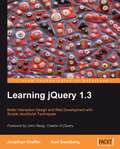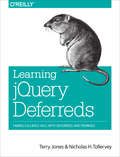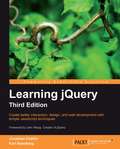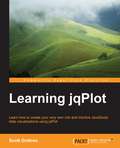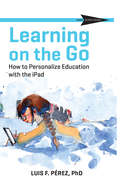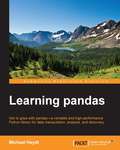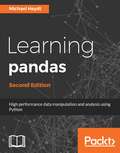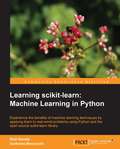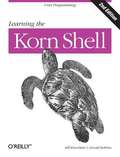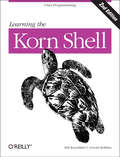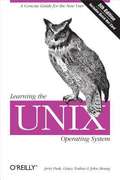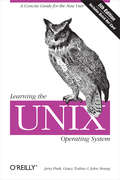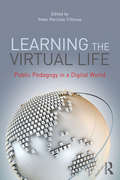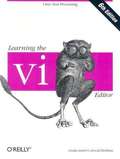- Table View
- List View
Learning jQuery 1.3
by Karl Swedberg Jonathan ChafferThis book begins with a tutorial to jQuery, followed by an examination of common, real-world client-side problems, and solutions to each of them making it an invaluable resource for answers to all your jQuery questions. This book is for web designers who want to create interactive elements for their designs, and for developers who want to create the best user interface for their web applications. Basic JavaScript programming knowledge is required. You will need to know the basics of HTML and CSS, and should be comfortable with the syntax of JavaScript. No knowledge of jQuery is assumed, nor is experience with any other JavaScript libraries required.
Learning jQuery 3 - Fifth Edition
by Adam Boduch Karl Swedberg Jonathan ChafferCreate efficient and smart web applications with jQuery 3.0 using this step-by-step practical tutorial About This Book • Create a fully featured and responsive client-side application using jQuery • Explore all the latest features of jQuery 3.0 and code examples updated to reflect modern JavaScript environments • Develop high performance interactive pages Who This Book Is For This book is ideal for client-side JavaScript developers. You do need to have any previous experience with jQuery, although basic JavaScript programming knowledge is necessary. What You Will Learn • Create custom interactive elements for your web designs • Find out how to create the best user interface for your web applications • Use selectors in a variety of ways to get anything you want from a page when you need it • Master events to bring your web pages to life • Add flair to your actions with a variety of different animation effects • Discover the latest features available in jQuery with the latest update of this incredibly popular title • Using jQuery npm Packages In Detail If you are a web developer and want to create web applications that look good, are efficient, have rich user interfaces, and integrate seamlessly with any backend using AJAX, then this book is the ideal match for you. We'll show you how you can integrate jQuery 3.0 into your web pages, avoid complex JavaScript code, create brilliant animation effects for your web applications, and create a flawless app. We start by configuring and customising the jQuery environment, and getting hands-on with DOM manipulation. Next, we'll explore event handling advanced animations, creating optimised user interfaces, and building useful third-party plugins. Also, we'll learn how to integrate jQuery with your favourite back-end framework. Moving on, we'll learn how the ECMAScript 6 features affect your web development process with jQuery. we'll discover how to use the newly introduced JavaScript promises and the new animation API in jQuery 3.0 in great detail, along with sample code and examples. By the end of the book, you will be able to successfully create a fully featured and efficient single page web application and leverage all the new features of jQuery 3.0 effectively. Style and approach Create efficient client-side apps that look great and run seamlessly across all devices with this step-by-step practical guide. There are illustrative examples for those who need extra help to get started with jQuery web development.
Learning jQuery Deferreds: Taming Callback Hell with Deferreds and Promises
by Terry Jones Nicholas H. TollerveyOrchestrating asynchronous function calls in JavaScript often leads to callback hell, but there is a reliable way to avoid this painful state of affairs. With this concise and simple guide, you’ll learn how to use jQuery deferreds and promises, an elegant approach for managing asynchronous calls in both client and server applications.This book contains 18 examples that use deferreds to solve progressively challenging real-world programming problems, along with 75 stimulating puzzles (and their solutions) that will help you understand how and when to use deferreds. Experienced JavaScript programmers will learn new tricks in a fun way, and become immersed in the practice of event-based programming.Understand the logic behind creating deferreds and returning promisesGet a structured explanation of jQuery’s deferred APIDelve into the dynamics of using deferredsExplore a broad collection of useful deferred recipes developed by the authorsGain hands-on experience by solving challenges that accompany each recipeGo deeper into deferreds: encounter novel abstractions and mind-bending use cases
Learning jQuery Fourth Edition
by Karl Swedberg Jonathan ChafferStep through each of the core concepts of the jQuery library, building an overall picture of its capabilities. Once you have thoroughly covered the basics, the book returns to each concept to cover more advanced examples and techniques.This book is for web designers who want to create interactive elements for their designs, and for developers who want to create the best user interface for their web applications. Basic JavaScript programming and knowledge of HTML and CSS is required. No knowledge of jQuery is assumed, nor is experience with any other JavaScript libraries.
Learning jQuery, Third Edition
by Karl Swedberg Jonathan ChafferStep through each of the core concepts of the jQuery library, building an overall picture of its capabilities. Once you have thoroughly covered the basics, the book returns to each concept to cover more advanced examples and techniques. This book is for web designers who want to create interactive elements for their designs, and for developers who want to create the best user interface for their web applications. Basic JavaScript programming and knowledge of HTML and CSS is required. No knowledge of jQuery is assumed, nor is experience with any other JavaScript libraries.
Learning jqPlot
by Scott GottreuIf you are a developer with a good understanding of JavaScript and jQuery and have been burdened with the task of analyzing and presenting some data, this book will provide you with the start you need to create some very attractive data visualizations.
Learning on the Go: How to Personalize Education with the iPad (CAST Skinny Books)
by Luis F. PerezThe iPad is a powerful educational device—versatile, mobile, flexible, and accessible to all learners, including those with disabilities. A huge number of up-to-date applications exponentially lift its value as a teaching and learning tool. In Learning on the Go: How to Personalize Education with the iPad, Luis F. Pérez provides savvy tips and strategies to turn the iPad’s transformative potential into effective classroom practice.
Learning on the Net: A Practical Guide to Enhancing Learning in Primary Classrooms
by Alan PritchardFirst Published in 2005. Routledge is an imprint of Taylor & Francis, an informa company.
Learning pandas
by Michael HeydtIf you are a Python programmer who wants to get started with performing data analysis using pandas and Python, this is the book for you. Some experience with statistical analysis would be helpful but is not mandatory.
Learning pandas
by Michael Heydt<P><P>Key Features <P><P>Employ the use of pandas for data analysis closely to focus more on analysis and less on programming <P><P>Get programmers comfortable in performing data exploration and analysis on Python using pandas <P><P>Step-by-step demonstration of using Python and pandas with interactive and incremental examples to facilitate learning <P><P>Book Description <P><P>This learner's guide will help you understand how to use the features of pandas for interactive data manipulation and analysis. <P><P>This book is your ideal guide to learning about pandas, all the way from installing it to creating one- and two-dimensional indexed data structures, indexing and slicing-and-dicing that data to derive results, loading data from local and Internet-based resources, and finally creating effective visualizations to form quick insights. You start with an overview of pandas and NumPy and then dive into the details of pandas, covering pandas' Series and DataFrame objects, before ending with a quick review of using pandas for several problems in finance. <P><P>With the knowledge you gain from this book, you will be able to quickly begin your journey into the exciting world of data science and analysis. <P><P>What You Will Learn <P><P>Install pandas on Windows, Mac, and Linux using the Anaconda Python distribution <P><P>Learn how pandas builds on NumPy to implement flexible indexed data <P><P>Adopt pandas' Series and DataFrame objects to represent one- and two-dimensional data constructs <P><P>Index, slice, and transform data to derive meaning from information <P><P>Load data from files, databases, and web services <P><P>Manipulate dates, times, and time series data <P><P>Group, aggregate, and summarize data <P><P>Visualize techniques for pandas and statistical data
Learning pandas - Second Edition
by Michael HeydtGet to grips with pandas—a versatile and high-performance Python library for data manipulation, analysis, and discovery About This Book • Get comfortable using pandas and Python as an effective data exploration and analysis tool • Explore pandas through a framework of data analysis, with an explanation of how pandas is well suited for the various stages in a data analysis process • A comprehensive guide to pandas with many of clear and practical examples to help you get up and using pandas Who This Book Is For This book is ideal for data scientists, data analysts, Python programmers who want to plunge into data analysis using pandas, and anyone with a curiosity about analyzing data. Some knowledge of statistics and programming will be helpful to get the most out of this book but not strictly required. Prior exposure to pandas is also not required. What You Will Learn • Understand how data analysts and scientists think about of the processes of gathering and understanding data • Learn how pandas can be used to support the end-to-end process of data analysis • Use pandas Series and DataFrame objects to represent single and multivariate data • Slicing and dicing data with pandas, as well as combining, grouping, and aggregating data from multiple sources • How to access data from external sources such as files, databases, and web services • Represent and manipulate time-series data and the many of the intricacies involved with this type of data • How to visualize statistical information • How to use pandas to solve several common data representation and analysis problems within finance In Detail You will learn how to use pandas to perform data analysis in Python. You will start with an overview of data analysis and iteratively progress from modeling data, to accessing data from remote sources, performing numeric and statistical analysis, through indexing and performing aggregate analysis, and finally to visualizing statistical data and applying pandas to finance. With the knowledge you gain from this book, you will quickly learn pandas and how it can empower you in the exciting world of data manipulation, analysis and science. Style and approach • Step-by-step instruction on using pandas within an end-to-end framework of performing data analysis • Practical demonstration of using Python and pandas using interactive and incremental examples
Learning scikit-learn: Machine Learning in Python
by Raul Garreta Guillermo MoncecchiThe book adopts a tutorial-based approach to introduce the user to Scikit-learn.If you are a programmer who wants to explore machine learning and data-based methods to build intelligent applications and enhance your programming skills, this the book for you. No previous experience with machine-learning algorithms is required.
Learning the Korn Shell
by Bill RosenblattThis Nutshell Handbook® is a thorough introduction to the Korn shell, both as a user interface and as a programming language.The Korn shell, like the C and Bourne shells, is a program that interprets UNIX commands. It has many features that aren't found in other shells, including command history (the ability to recall and edit previous commands). The Korn shell is also faster; several of its features allow you to write programs that execute more quickly than their Bourne or C shell equivalents.This book provides a clear and concise explanation of the Korn shell's features. It explains ksh string operations, co-processes, signals and signal handling, and one of the worst "dark corners" of shell programming: command-line interpretation. It does this by introducing simple real-life examples and then adding options and complexity in later chapters, illustrating the way real-world script development generally proceeds. An additional (and unique) programming aid, a Korn shell debugger (kshdb), is also included.Learning the Korn Shell is an ideal resource for many UNIX users and programmers, including software developers who want to "prototype" their designs, system administrators who want to write tools for their own use, and even novices who just want to use some of ksh's more advanced interactive features.
Learning the Korn Shell, 2nd Edition
by Arnold Robbins Bill RosenblattLearning the Korn Shell is the key to gaining control of the Korn shell and becoming adept at using it as an interactive command and scripting language. Readers will learn how to write many applications more easily and quickly than with other high-level languages. A solid offering for many years, this newly revised title inherits a long tradition of trust among computer professionals who want to learn or refine an essential skill.
Learning the Korn Shell: Unix Programming
by Arnold Robbins Bill RosenblattThe Korn shell is an interactive command and scripting language for accessing Unix® and other computer systems. As a complete and high-level programming language in itself, it's been a favorite since it was developed in the mid 1980s by David G. Korn at AT&T Bell Laboratories. Knowing how to use it is an essential skill for serious Unix users. Learning the Korn Shell shows you how to use the Korn shell as a user interface and as a programming environment.Writing applications is often easier and quicker with Korn than with other high-level languages. Because of this, the Korn shell is the most often used shell in commercial environments and among inexperienced users. There are two other widely used shells, the Bourne shell and the C shell. The Korn shell, or ksh, has the best features of both, plus many new features of its own. ksh can do much to enhance productivity and the quality of a user's work, both in interacting with the system, and in programming. The new version, ksh93, has the functionality of other scripting languages such as awk, icon, Perl, rexx, and tcl.Learning the Korn Shell is the key to gaining control of the Korn shell and becoming adept at using it as an interactive command and scripting language. Prior programming experience is not required in order to understand the chapters on basic shell programming. Readers will learn how to write many applications more easily and quickly than with other high-level languages. In addition, readers will also learn about Unix utilities and the way the Unix operating system works in general. The authors maintain that you shouldn't have to be an internals expert to use and program the shell effectively.The second edition covers all the features of the current version of the Korn shell, including many new features not in earlier versions of ksh93, making it the most up-to-date reference available on the Korn shell. It compares the current version of the Korn shell to several other Bourne-compatible shells, including several Unix emulation environments for MS-DOS and Windows. In addition, it describes how to download and build ksh93 from source code.A solid offering for many years, this newly revised title inherits a long tradition of trust among computer professionals who want to learn or refine an essential skill.
Learning the UNIX Operating System, 4th Edition
by Jerry Peek John Strang Grace Todino-GonguetIf you are new to UNIX, this concise introduction will tell you just what you need to get started and no more. Why wade through a 600-page book when you can begin working productively in a matter of minutes? It's an ideal primer for Mac and PC users of the Internet who need to know a little bit about UNIX on the systems they visit. This book is the most effective introduction to UNIX in print. The fourth edition covers the highlights of the Linux operating system. It's a handy book for someone just starting with UNIX or Linux, as well as someone who encounters a UNIX system on the Internet. And it now includes a quick-reference card. Topics covered include: Linux operating system highlights Logging in and logging out Window systems (especially X/Motif) Managing UNIX files and directories Sending and receiving mail Redirecting input/output Pipes and filters Background processing Basic network commandsv
Learning the Unix Operating System, 5th Edition
by Jerry Peek John Strang Grace Todino-GonguetIf you're new to Unix, this concise book will tell you just what you need to get started and no more. This fifth edition is the most effective introduction to Unix in print, covering Internet usage for email, file transfers, and web browsing. It's an ideal primer for Mac and PC users who need to know a little about Unix on the systems they visit.
Learning the Unix Operating System: A Concise Guide for the New User
by Jerry Peek John Strang Grace TodinoIf you are new to Unix, this concise book will tell you just what you need to get started and no more. Unix was one of the first operating systems written in C, a high-level programming language, and its natural portability and low price made it a popular choice among universities. Initially, two main dialects of Unix existed: one produced by AT&T known as System V, and one developed at UC Berkeley and known as BSD. In recent years, many other dialects have been created, including the highly popular Linux operating system and the new Mac OS X (a derivative of BSD).Learning the Unix Operating System is a handy book for someone just starting with Unix or Linux, and it's an ideal primer for Mac and PC users of the Internet who need to know a little about Unix on the systems they visit. The fifth edition is the most effective introduction to Unix in print, covering Internet usage for email, file transfers, web browsing, and many major and minor updates to help the reader navigate the ever-expanding capabilities of the operating system:In response to the popularity of Linux, the book now focuses on the popular bash shell preferred by most Linux users.Since the release of the fourth edition, the Internet and its many functions has become part of most computer user's lives. A new chapter explains how to use ftp, pine for mail, and offers useful knowledge on how to surf the web.Today everyone is concerned about security. With this in mind, the author has included tips throughout the text on security basics, especially in the Internet and networking sections.The book includes a completely updated quick reference card to make it easier for the reader to access the key functions of the command line.
Learning the Virtual Life: Public Pedagogy in a Digital World
by Peter Pericles TrifonasDigital technologies have transformed cultural perceptions of learning and what it means to be literate, expanding the importance of experience alongside interpretation and reflection. Learning the Virtual Life offers ways to consider the local and global effects of digital media on educational environments, as well as the cultural transformations of how we now define learning and literacy. While some have welcomed the educational challenges of digital culture and emphasized its possibilities for individual emancipation and social transformation in the new information age, others accuse digital culture of absorbing its recipients in an all-pervasive virtual world. Unlike most accounts of the educational and cultural consequences of digital culture, Learning the Virtual Life presents a neutral, advanced introduction to the key issues involved with the integration of digital culture and education. This edited collection presents international perspectives on a wide range of issues, and each chapter combines upper-level theory with "real-world" practice, making this essential reading for all those interested in digital media and education.
Learning the Yahoo! User Interface library
by Dan WellmanThe book is a tutorial, leading the reader first through the basics of the YUI library before moving on to more complex examples involving the YUI controls and utilities. The book is heavily example driven, and based around an approach of tinkering and extending to improve. This book is for web developers comfortable with JavaScript and CSS, who want to use the YUI library to easily put together rich, responsive web interfaces. No knowledge of the YUI library is presumed.
Learning the bash Shell, 3rd Edition
by Cameron NewhamThis refreshed edition serves as the most valuable guide yet to the bash shell. It's full of practical examples of shell commands and programs guaranteed to make everyday use of Linux that much easier. Includes information on key bindings, command line editing and processing, integrated programming features, signal handling, and much more!
Learning the bash Shell, Second Edition
by Cameron Newham Bill RosenblattThis second edition covers all of the features of bash Version 2.0, while still applying to bash Version 1.x. It includes one-dimensional arrays, parameter expansion, more pattern-matching operations, new commands, security improvements, additions to ReadLine, improved configuration and installation, and an additional programming aid, the bash shell debugger.
Learning the bash Shell: Unix Shell Programming
by Cameron NewhamO'Reilly's bestselling book on Linux's bash shell is at it again. Now that Linux is an established player both as a server and on the desktop Learning the bash Shell has been updated and refreshed to account for all the latest changes. Indeed, this third edition serves as the most valuable guide yet to the bash shell.As any good programmer knows, the first thing users of the Linux operating system come face to face with is the shell the UNIX term for a user interface to the system. In other words, it's what lets you communicate with the computer via the keyboard and display. Mastering the bash shell might sound fairly simple but it isn't. In truth, there are many complexities that need careful explanation, which is just what Learning the bash Shell provides.If you are new to shell programming, the book provides an excellent introduction, covering everything from the most basic to the most advanced features. And if you've been writing shell scripts for years, it offers a great way to find out what the new shell offers. Learning the bash Shell is also full of practical examples of shell commands and programs that will make everyday use of Linux that much easier. With this book, programmers will learn:How to install bash as your login shellThe basics of interactive shell use, including UNIX file and directory structures, standard I/O, and background jobsCommand line editing, history substitution, and key bindingsHow to customize your shell environment without programmingThe nuts and bolts of basic shell programming, flow control structures, command-line options and typed variablesProcess handling, from job control to processes, coroutines and subshellsDebugging techniques, such as trace and verbose modesTechniques for implementing system-wide shell customization and features related to system security
Learning the iOS 4 SDK for JavaScript Programmers: Create Native Apps with Objective-C and Xcode
by Danny GoodmanIs it possible for JavaScript programmers to learn Apple's iOS 4 SDK and live to tell the tale? Technology guru Danny Goodman did, and with this book he leaves a well-marked trail for you to follow. An authority on JavaScript since its inception, Goodman understands the challenges you might face in creating native iOS apps with this SDK, and introduces Xcode, Objective-C, and Cocoa Touch in a context you'll readily understand.Why bother with the SDK when you can simply build web apps for Apple's iOS devices? Web apps can't access an iPhone's music library, camera, or iOS system software for maps, audio, and more. Nor can you sell web apps in the App Store. If you want to take full advantage of the iPhone and iPad, iOS 4 SDK is your tool -- and this is your book. Includes full coverage of iOS SDK 4.2.Learn the distinction between web app and iOS native app programmingCreate a workbench app to test code snippets throughout the learning processGet a structural view of an iOS app, and compare the process of building objects in Objective-C versus JavaSciptDiscover how your code launches iOS apps and makes them user-readyLearn about iOS memory management details that are different from JavaScript, including pointers and data typesUse Objective-C and Cocoa Touch to implement common JavaScript tasks
Learning the vi Editor, Sixth Edition
by Linda Lamb Arnold RobbinsThis completely updated guide to editing with vi, the editor available on nearly every Unix system, now covers four popular viclones and includes command summaries for easy reference. It starts with the basics, followed by more advanced editing tools, such as ex commands, global search and replacement, and a new feature, multiscreen editing.
